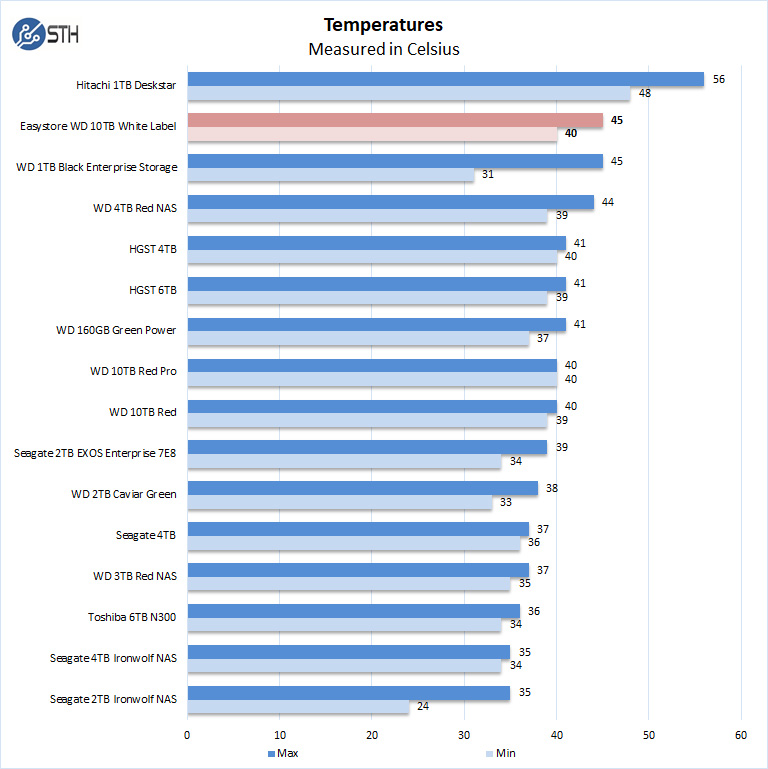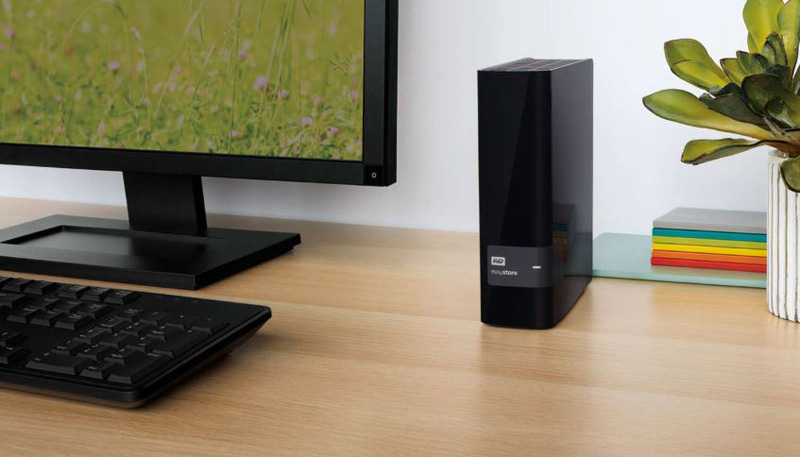WD WD100EFAX v. WD Red 10TB Hard Drive Temperatures
As part of our process, we are measuring drive temperatures in our enclosure. We wanted to give a standard test platform and location so we can see if there are benefits to power saving features and casing design.

Overall the 10TB WD100EMAZ White Label drive runs about 5C warmer than the middle of the pack when running benchmarks, but the minimum is within 1C of what we are seeing with most drives, including the WD 10TB Red drive. The difference between idle and Max temperatures is a 5C difference which is more than we are seeing from most modern helium-filled drives.
There is clearly some firmware difference driving this delta between the Easystore drive and a standard WD Red 10TB hard drive.
Final Words
Taking a close look at the WD Easystore 10TB USB Desktop Backup and Storage device has been an interesting test. At the time we did not have an HDD database to use to compare drives, we grabbed up many HDD’s we had and starting benching sixteen different HDD’s. While doing these benchmarks, we saw in our forums many posters finding WD 10TB Red drives inside and others finding these White Label HDDs. I know Patrick, for example, picked up a few dozen for the lab and they were all WD100EMAZ models.

A burning question is whether the WD100EMAZ (Easystore white label) is the same as the WD100EFAX (WD Red.) What we determined is they are not exact matches, but performance is reasonably close to each other. WD touts a number of features for their Red lineup making them more suitable for NAS applications.
From a hardware perspective, they look almost identical, but there seem to be at least some firmware differences between the two models. We ran into the 3.3V Pin issue with the power supply on our test bench, but not with the Synology NAS boxes we have, nor many servers we use.
The bonus for this kit is the easystore 32GB USB 3.0 drive which makes these deals hard to pass up on the Best Buy versions. One ends up comparing a $300+ WD Red 10TB drive to a $180 or so external drive bundled with a 32GB USB stick. One has to weigh whether the slightly better performance, slightly lower temperatures, ease of installation, and warranty make up for the cost advantages shucking a drive offers. If the difference was smaller, we would say not, but this can be seen as an 80% price premium.
For those users with a $305 budget, and who are buying a single drive, we think that the WD Red 10TB is clearly the option to buy. If you cannot afford to lose a $180 external drive that fails then this option is frankly not for you. If on the other hand, you have $1220 and are choosing between 4x $305 WD Red 10TB drives ($1220) or 4x $180 ($720) WD Easystore externals and shucking, one can make a valid business decision to forgo the numerous benefits of the WD Red series and self-warranty buying two extra external drives in case of failure.
Either way, the WD100EMAZ white label drives perform very well and the deals we find on these Easystore kits to be very compelling and worth getting. Many of STH readers have purchased large numbers of these kits when they go on sale at Best Buy, and they are happy with them.




I like that a big site actually did this. Good to know there’s a difference even if it’s small.
I did this with the MyBook 8TB drives 2 years ago and put them in my OMV Nas. 6 months later one totally died. At that point I got a IronWolf drive as a replacement to have some differentiation. The other MyBook drive has been chugging along for the last 2,5 years though.
I got 6 of the 8TB version about a year ago. Of the 3 that I’ve pulled so far, all are the WD80EFZX. One is being used as purchased and the other 2 are waiting to be opened probably, once I figure out my longer term NAS setup.
My 2 cents – get a good power supply like a Seasonic Gold or Titanium if you’re having problems with drive failures. My combination of 40 plus various Seagates, WD, and Toshiba have never experienced a drive failure. Drives do fail of course, but clean power is important.
I just got two of the 8TB yesterday they were both the EFZX, even between the two one was about 5-10MB/s faster when I did a 4 hour burn-in. Neither had any 3.3v issues in my system. One was straight to the MB the other was in a 3 disk hot-swap enclosure I got off of Amazon.
sorry I meant EAMZ same at the 10TB
I have a question, WHY can’t these drives be set up so that there is a DUEL storage system. Like you write to you D: Drive and it automatically copies the data that you just wrote to THIS 10Tdrive? –you have a double backup of your data? ONE on your principal drive and on the 10 T drive.
With all of this space, you can then keep a separate BACKUP of data every month! BUT the duel back up happens immediately? everyday! every time you access your hard drive.
AJ, if you want redundancy, I use a Drobo 5N2. 5 bays and you can set them up to be redundant against 1 HD failure or Dual HD failure. But note that dual redundancy really eats up drive space. I’m currently running 44 TB worth of drives (2-10s and 3-8s) and have 31 TB available with standard redundancy and 22 TB with dual redundancy. But since I have almost 1200 movies, over 80 complete tv series, over 6000 albums and some photography work on it, dual redundancy is just the thing for me. I would hate to loose that stuff.
AJ, that is called RAID 1. A mirror of the drive, so the data is on 2 drives, if one drive fails, the other takes over.
There is also software that will do this for you, such as DriverPool for Windows, or on Linux certain filesystems do this for you when you tell them to, such as BTRFS, ZFS and others.
Excellent professional testing and an answer to the eternal question regarding these drives–what are they?
We purchased 2 for use as is as just secondary backups as they were cheap and it seems they will do their job well.
Any test done on the drives shucked from a WD MyBook 8TB?:
Model: WD80EZAZ-11TDBA0
I have 4 of these (out of 24 drives) in a FreeNAS setup since a few months and 2 of them are already returning a 50-150 “Currently unreadable (pending) sectors”.
I bought 4 of these not knowing they had come from am external kit- I installed them into my Synology 4 port NAS. In 4 months I have had to run Synology repair because of notices that a drive was failing. In fact the NAS. Is running a repair fight now (and it takes at least 36-40 hours. That didn’t for me.I bought a 10 Tb WD Red to replace the troublesome WD White, We will see what happens but I do not like these drives for NAS, Beware
on the black sharpie or magic marker for labeling usb another tip is to cover the writing with tape afterwards as the ink tends to wear off over time
You should correct wrong information in your otherwise great review. In the United States, shucking a drive does not invalidate warranty unless the process of shucking damaged the drive. This would have to be proven by WD. Therefore one could shuck the drive, use it internally, have it go bad then put it back into the enclosure and cigarette a right to claim warranty as long as they did not damage the enclosure or drive while shucking.
VJ you have it right in theory and wrong in practice. It is up to WDC to warranty ANY drive, period. If you have a problem with them, you will find it much more expensive to fight with them about it than to buy another drive by another manufacturer.
Does the WD100EMAZ use SMR or CMR recording technology?
@ Brian Mucklow – it’s PMR (Conventional).
Good read